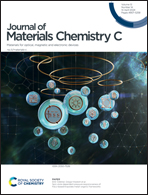Polyvinyl alcohol electrolyte-gated oxide transistors with tetanization activities for neuromorphic computing†
Abstract
Adoption of biodegradable materials in neuromorphic devices has great potential in “green” low-power neuromorphic systems. In this work, polyvinyl alcohol (PVA)-gated indium tin oxide (ITO) neuromorphic transistors were fabricated. The device demonstrated good electrical performance. Basic synaptic functions and dendrite functions were mimicked due to unique proton-related interfacial coupling. Tetanization activities were observed on the PVA-gated ITO neuromorphic transistor by introducing historical spikes, demonstrating both post-tetanic potentiation and post-tetanic depression. With multi-level synaptic weights, a high recognition accuracy of ∼90.51% was demonstrated for MNIST handwritten digits. Most importantly, the PVA-gated ITO neuromorphic transistors have ultra-low energy consumption of ∼36 aJ and a quality factor of ∼0.0036 fJ V. The device still demonstrated a high sensitivity of ∼6.6 dB at such low energy consumption. Moreover, the device could be dissolved in deionized water. Thus, PVA-gated oxide neuromorphic transistors have the potential for energy efficient “green” neuromorphic platforms.



 Please wait while we load your content...
Please wait while we load your content...